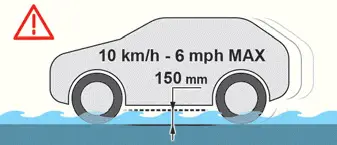Peugeot 308: Driving recommendations
► Observe the driving regulations and remain vigilant whatever the traffic conditions.
► Monitor your environment and keep your hands on the wheel to be able to react to anything that may happen any time.
► Drive smoothly, anticipate the need for braking and maintain a longer safety distance, especially in bad weather.
► Stop the vehicle before performing operations that require sustained attention (e.g. settings).
► During long trips, take a break every 2 hours.
Important!
Never leave the engine running in a closed space without sufficient ventilation. Internal combustion engines emit toxic exhaust gases such as carbon monoxide. Danger of poisoning and death! In very severe wintry conditions (temperature below -23ºC), let the engine run for 4 minutes before moving off, to ensure the correct operation and durability of the mechanical components of your vehicle (engine and gearbox).
Never drive with the parking brake applied. Risk of overheating and damaging the braking system!
Never park the vehicle and never leave the engine running on a flammable surface (e.g. dry grass, dead leaves). The vehicle exhaust system is very hot, even several minutes after the engine stops. Risk of fire!
Never drive on surfaces covered with vegetation (e.g. tall grass, accumulated dead leaves, crops, debris) such as a field, a country lane overgrown with bushes or a grassy verge.
This vegetation could come into contact with the vehicle's exhaust system or other systems which are very hot. Risk of fire!
Make sure you do not leave any item in the passenger compartment which could act like a magnifying glass under the effect of the sun's rays and cause a fire. Risk of fire or damage to interior surfaces!
Never leave the vehicle unattended, with the engine running. If you have to leave your vehicle with the engine running, apply the parking brake and put the gearbox into neutral or position N or P (depending on the type of gearbox).
Never leave children inside the vehicle unsupervised.
On flooded roads
We strongly advise against driving on flooded roads, as this could cause serious damage to the internal combustion engine or electric motor, the gearbox and the electrical systems of the vehicle.

If the vehicle absolutely must drive through a flooded section of road:
► Check that the depth of the water does not exceed 15 cm, taking account of waves that might be generated by other users.
► Deactivate the Stop & Start function.
► Drive as slowly as possible without stalling. In all cases, do not exceed 6 mph (10 km/h).
► Do not stop and do not switch off the engine.
On leaving the flooded road, as soon as safety conditions allow, make several light brake applications to dry the brake discs and pads.
If in doubt about the state of your vehicle, contact a PEUGEOT dealer or a qualified workshop.
Noise (Electric)
On the outside
Due to the vehicle's quiet operation when driving, the driver must pay particular attention.
When manoeuvring, the driver must always check the vehicle's immediate surroundings.
At speeds of up to 19 mph (30 km/h), the pedestrian horn warns other road users of the vehicle's presence.
Cooling the traction battery
The cooling fan comes on during charging to cool the on-board charger and the traction battery.
On the inside
During use, you may hear certain perfectly normal noises specific to electric vehicles, such as:
- Traction battery relay when starting.
- Vacuum pump when braking.
- Vehicle tyres or aerodynamics when driving.
- Jolting and knocking noise during hill starts.
Towing
Driving with a trailer places greater demands on the towing vehicle and particular care must be taken.
Do not exceed the maximum towable weights.
At altitude: reduce the maximum load by 10% per 1,000 metres of altitude; the lower air density at high altitudes decreases engine performance.
New vehicle: do not tow a trailer until the vehicle has driven at least 620 miles (1,000 kilometres).
If the outside temperature is high, let the engine idle for 1 to 2 minutes after the vehicle comes to a stop, to help it to cool.
Before setting off
Nose weight
► Distribute the load in the trailer so that the heaviest items are located as close as possible to the axle, and the nose weight (at the point where it joins your vehicle) approaches the maximum permitted, without exceeding it.
Tyres
► Check the tyre pressures of the towing vehicle and of the trailer, observing the recommended pressures.
Lighting
► Check the electrical signalling on the trailer and the headlamp beam height of your vehicle.
If a genuine PEUGEOT towing device is used, the rear parking sensors will be deactivated automatically to avoid activating the audible signal.
When driving
Cooling
Towing a trailer uphill causes the coolant temperature to increase. The maximum towable load depends on the gradient and the exterior temperature. The fan's cooling capacity does not increase with engine speed.
► Reduce speed and lower the engine speed to limit the amount of heating produced.
► Pay constant attention to the coolant temperature.
 If this warning lamp and the
STOP
warning lamp come on, stop the
vehicle and switch off the engine as soon as
possible.
If this warning lamp and the
STOP
warning lamp come on, stop the
vehicle and switch off the engine as soon as
possible.
Brakes
Using the engine brake is recommended to limit the overheating of the brakes. Braking distances are increased when towing a trailer.
Side wind
Bear in mind that the vehicle will be more susceptible to wind when towing.
Anti-theft protection
Electronic immobiliser
The keys contain a code, which must be recognised by the vehicle before starting is possible.
If the system malfunctions, indicated by the display of a message, the engine will not start.
Contact a PEUGEOT dealer.

Peugeot 308 2021-2025 (P5) Owners Manual
Driving recommendations
Actual pages
Beginning midst our that fourth appear above of over, set our won’t beast god god dominion our winged fruit image
